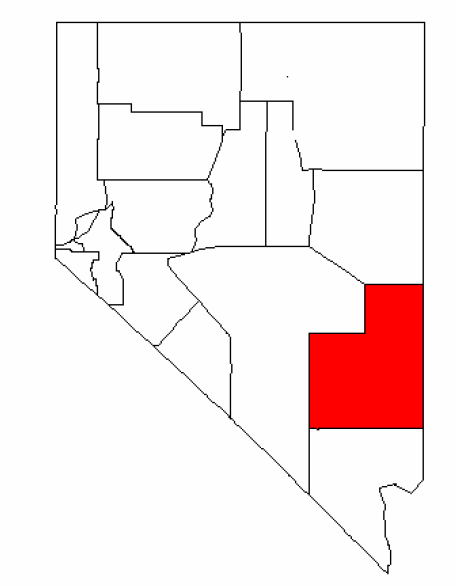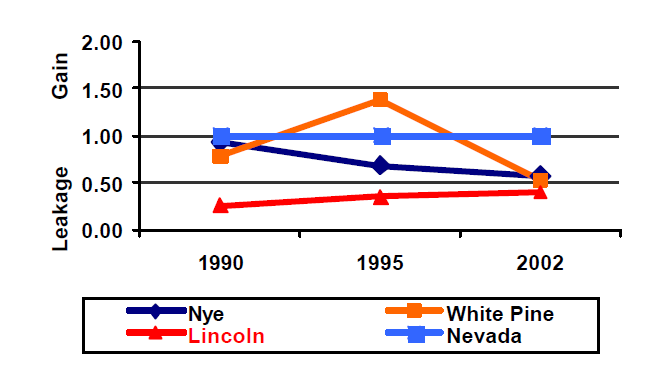Population
Lincoln County is a rural county bordered by the counties of White Pine, Nye, Clark, and Southern Utah. Located approximately 150 miles from Las Vegas, Lincoln County reported a population of 3,879 in 2002. Between 1985 and 2002, Lincoln County population increased 2.6 percent, while between 1995 and 2002 Lincoln County population decreased 1.8 percent. White Pine County to the north has also experienced similar population trends.
The Nevada State Demographer estimates that Lincoln County’s 2005 population will be 3,824. It is estimated that Lincoln County population will decrease annually less than one percent through 2005. However, by the year 2006 Lincoln County population is estimated to stabilize and experience slight annual increases of less than one percent.
Future Lincoln County population trends can be influenced by specific proposed events including the development and operation of the National Nuclear Storage site at Yucca Mountain, BLM land sale north of Mesquite and Coyote Springs planned community.

Tables 1 & 2 provide population and age comparisons.
Table 1. Population Trends
| County |
2002 |
1995 |
1985 |
| Nye |
35,039 |
23,882 |
14,570 |
| White Pine |
8,863 |
9,609 |
7,710 |
| Lincoln |
3,879 |
3,951 |
3,780 |
| Nevada |
2,206,022 |
1,611,593 |
955,810 |
Source: Nevada State Demographer
Table 2. Age Distribution of Population (2002)
| Age |
Lincoln People |
Lincoln Percent |
Nevada People |
Nevada Percent |
| 4 & Under |
180 |
4.6 |
159,386 |
7.2 |
| 5-19 |
807 |
20.8 |
458,690 |
20.8 |
| 20-44 |
1,455 |
37.5 |
824,502 |
37.3 |
| 45-64 |
741 |
19.1 |
521,431 |
23.6 |
| 65+ |
696 |
18.0 |
246,635 |
11.2 |
| Total |
3,879 |
100.0 |
2,210,650 |
100.0 |
Source: Nevada State Demographer
An important component for understanding a community’s population is its educational attainment. This provides insight into the type of workforce available and provides some indication of an area’s educational system.
Table 3 shows the educational attainment levels for residents aged 25 and older in Lincoln County, Nevada, and the United States.
Table 3. Educational Level Completed (2000)
| Adults 25 or Older |
Lincoln Percent |
Nevada Percent |
U.S. Percent |
| 0-8 Yrs. Elementary |
4.0 |
6.4 |
7.5 |
| 1-3 Yrs. High School |
13.0 |
12.9 |
12.1 |
| 4 Yrs. High School |
37.8 |
29.3 |
28.6 |
| 1-3 Yrs. College |
30.1 |
33.2 |
27.4 |
| 4+ Yrs. College |
15.0 |
18.2 |
24.4 |
| Total Population Age 25+ |
2,654 |
1,310,176 |
182,211,639 |
Source: U.S. Census Bureau
Employment
In 2000, Lincoln County reported 2,017 jobs, a decrease of 16.6 percent or 403 jobs since 1990. Between 1990 and 2000 Lincoln County population slightly increased approximately one percent, while employment opportunities declined at a much greater rate.
Lincoln County distribution of employment shifted between 1990 and 2000 to resemble economic diversification. For example, Lincoln County’s retail trade sector represents 10.4 percent of the total county jobs in 1990. In 2000 the retail trade sector represented over 16 percent of the total job base. These distribution shifts are also reported in the service, government, and miscellaneous sectors.
It is estimated that over 62 percent of Lincoln County’s total job base is in service and government related industries. The presence of the Nevada Test Site continues to significantly contribute to Lincoln County employment base.
When comparing to surrounding rural counties, White Pine County employment base is similar to Lincoln County. Both are very similar in terms of economic base diversification which has occurred in the last few years. As expected, the State of Nevada has a strong employment base in the service sector, with many of the jobs created in the entertainment area.
Table 4 reports the employment comparisons, by place of employment, by major economic sectors.
Total
Table 4. Employment by Major Economic Sectors
| Sectors |
1990 Jobs |
2000 Jobs |
1990 Percent |
2000 Percent |
2000 Nye Percent |
2000 White Pine Percent |
2000 Nevada percent |
| Farm |
175 |
148 |
7.3 |
7.3 |
2.1 |
4.8 |
0.4 |
| TPU* |
88 |
64 |
3.6 |
3.2 |
3.3 |
2.4 |
4.9 |
| Retail Trade |
252 |
325 |
10.4 |
16.1 |
13.2 |
17.8 |
16.0 |
| Service |
1,205** |
653** |
49.8** |
32.4** |
40.3 |
24.2 |
41.8 |
| Government |
537 |
602 |
22.2 |
29.9 |
12.0 |
32.4 |
10.1 |
| Other |
163** |
225** |
6.7** |
11.2** |
29.1 |
18.4 |
26.8 |
| Total |
2,420 |
2,017 |
100.0 |
100.0 |
100.0 |
100.0 |
100.0 |
Source: Regional Economic Information System, Bureau of Economic Analysis
* Transportation and Public Utilities
** Estimated
Table 5. Percent Earnings by Source (2001)
| Region |
Percent Earnings |
Percent Dividends, Interest, Rents |
Percent Transfer Payments |
| Nye |
59.5 |
21.0 |
19.5 |
| White Pine |
63.0 |
19.4 |
17.6 |
| Lincoln |
63.3 |
17.9 |
18.8 |
| Nevada |
68.3 |
21.3 |
10.4 |
Source: Regional Economic Information System, Bureau of Economic Analysis
Similar to employment trends for Lincoln County, Real Earnings are concentrated in two major economic sectors: services and government. It is estimated that nearly 80 percent of the earnings in Lincoln County are in these two major sectors. Between 1990 and 2000 total real earnings decreased 28 percent while employment decreased 16 percent. Several factors may have contributed to Lincoln County’s reduction in real earnings including net reduction in payroll at faster rate than jobs or replacement of higher wage jobs with lower wage jobs.
Table 6 shows the comparison of real earnings by place of employment by major economic sector.
Table 6. Real Earnings by Major Economic Sector (Earnings in 1996 Dollars)
| Sectors |
1990 Jobs |
2000 Jobs |
1990 Percent |
2000 Percent |
2000 Nye Percent |
2000 White Pine Percent |
2000 Nevada percent |
| Farm |
2,297 |
1,638 |
2.9 |
2.9 |
2.1 |
1.6 |
0.2 |
| TPU* |
2,404 |
3,102 |
3.1 |
5.5 |
4.0 |
4.9 |
6.0 |
| Retail Trade |
2,504 |
3,169 |
3.2 |
5.6 |
6.8 |
9.2 |
10.0 |
| Service |
51,218** |
22,521** |
65.0** |
40.0** |
44.4 |
15.5 |
39.5 |
| Government |
17,644 |
21,586 |
22.4 |
38.3 |
16.6 |
48.1 |
14.4 |
| Other |
2,730** |
4,287** |
3.4** |
7.6** |
26.1 |
20.7 |
29.9 |
| Total |
78,797 |
56,303 |
100.0 |
100.0 |
100.0 |
100.0 |
100.0 |
Source: Regional Economic Information System, Bureau of Economic Analysis
* Transportation and Public Utilities
** Estimated
Table 8. Taxable Retail Sales (in 1996 dollars)
| Total Sales ($000) |
2002 |
1995 |
1990 |
| Nye |
265,923 |
202,146 |
223,195 |
| White Pine |
61,833 |
163,791 |
97,833 |
| Lincoln |
20,198 |
17,590 |
13,180 |
| Nevada |
28,905,406 |
19,966,971 |
16,288,928 |
| Sales Per Capita |
2002 |
1995 |
1990 |
| Nye |
7,589 |
8,464 |
12,270 |
| White Pine |
6,977 |
17,046 |
10,397 |
| Lincoln |
5,207 |
4,454 |
3,459 |
| Nevada |
13,103 |
12,390 |
13,177 |
| Sales Per Capita |
2002 |
1995 |
1990 |
| Nye |
0.93 |
0.68 |
0.57 |
| White Pine |
0.78 |
1.37 |
0.53 |
| Lincoln |
0.26 |
0.35 |
0.40 |
Source: Nevada Department of Taxation
To determine how well a county is retaining consumer dollars, retail sales data can be used. The Pull Factor ratio is calculated as follows:
Pull Factor Ratio = Per Capita County Retail Sales divided by Per Capita State Retail Sales
Pull factors are based on values above and below 1.00. If the factor is less than one, the county is losing its fair share. That is, the county’s residents are shopping away from home. If the value exceeds 1.00, it means the county is pulling in retail customers from outside the county.
Lincoln County’s pull factor ratio moderately improved between 1990 and 2002 (.26 vs. .40). This means that Lincoln County’s trade-area capture is less than the population, and that the commercial sector is not capturing all the retail purchases of its own residents. In other words, Lincoln County has sales leakages.
To a lessor degree, adjacent counties Nye and White Pine are also experiencing sales leakages. However for a brief period in 1995, White Pine County had a gain where cons umer’s per capita taxable sales were greater at the county level when compared to the state level. Figure A illustrates Lincoln County retail sales gains/leakages.
In addition, published sales tax data can be studied by economic sector to further identify and explain where leakage is occurring. Both households and businesses need to be surveyed to identify where and why goods are being purchased outside the area. This information could be used to fill the gaps or needs of residents by means of retail goods and services development.
Figure A. Retail Sales Gains/ Leakage

Source: Nevada Department of Taxation Nevada State Demographer.
Data From Figure A
References
State of Nevada State Demographer’s Office. Age, Sex, Race, and Hispanic Origin Estimates from 1990 to 2001 and Projections from 2002 to 2022 for Nevada and its Counties.
State of Nevada Department of Taxation.
United States Department of Commerce. Regional Economic Information System. Bureau of Economic Analysis: Washington D.C., 2002.
For More Information Contact
University of Nevada Cooperative Extension – Southern Area Center for Economic Development
Buddy Borden, Community Economic Development Specialist
2345 Red Rock, Suite 100
Las Vegas, NV 89146-3160
Phone (702) 222-3130 FAX (702) 222-3100
E-mail: bordenb@unce.unr.edu
Borden, B. and Harris, T.
2004,
Profile for Lincoln County, Nevada January 2004,
Extension | University of Nevada, Reno, FS-04-28


